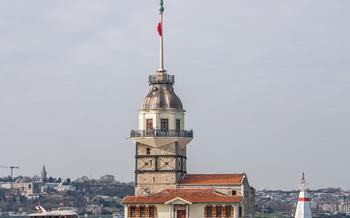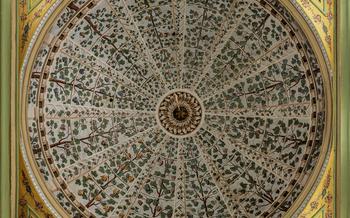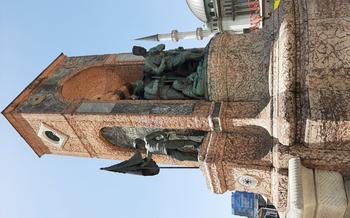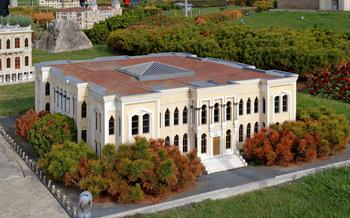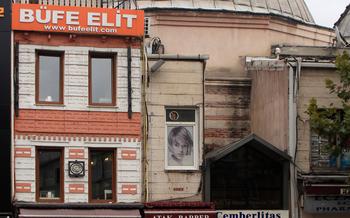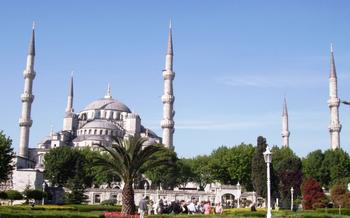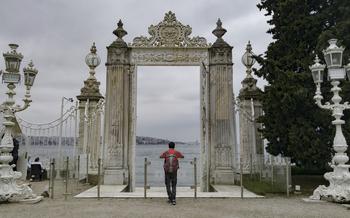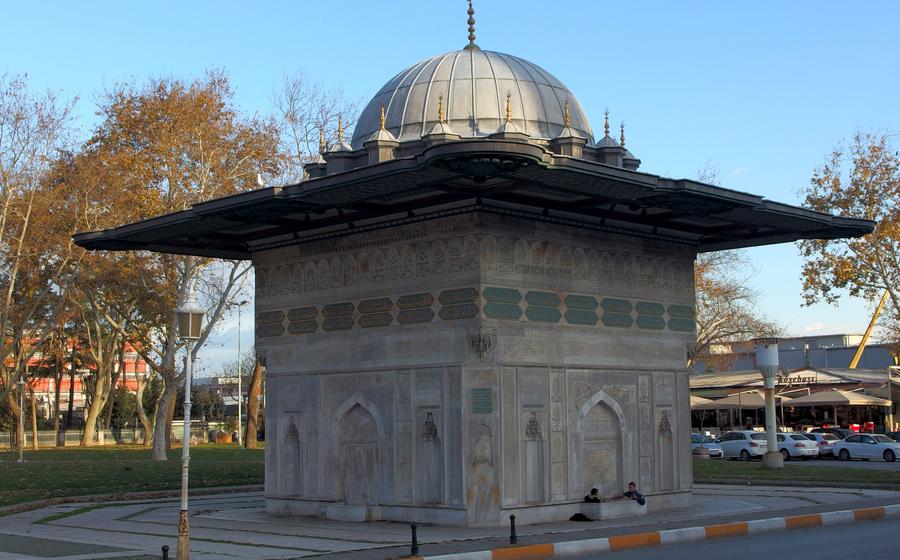
Tophane Fountain
- Tophane Fountain: A Historical Landmark in Istanbul
- The History and Origin of the Tophane Fountain
- Exploring the Tophane Fountain's Design and Architecture
- Comparison with Other Ottoman Fountains
- The Cultural Significance of the Tophane Fountain
- Location and Accessibility of the Tophane Fountain
- Visiting the Tophane Fountain: What to Expect
- Tophane Fountain as a Symbol of Ottoman Engineering
- Tophane Fountain's Place in Istanbul's Urban Fabric
- The Fountain's Role in Daily Life and Community
- Exploring the Neighborhood Surrounding the Tophane Fountain
- Tophane Fountain as a Source of Inspiration
- Tophane Fountain's Contribution to Tourism and Cultural Exchange
- Preservation and Conservation Efforts for the Tophane Fountain
- Insider Tip: Hidden Gems Near the Tophane Fountain
Tophane Fountain: A Historical Landmark in Istanbul
The Tophane Fountain, an iconic landmark in Istanbul, Turkey, stands as a testament to the city's rich history and architectural prowess. Built in the 18th century during the reign of Sultan Ahmed III, the fountain holds significant historical and cultural value. Its strategic location near the Tophane district, once a bustling naval shipyard, adds to its importance. The fountain not only served as a source of fresh water but also symbolized the empire's maritime power and engineering achievements. Its intricate design, featuring delicate carvings and inscriptions, reflects the artistic and cultural influences of the Ottoman era. Today, the Tophane Fountain remains a popular tourist attraction, inviting visitors to delve into Istanbul's fascinating past as they admire its timeless beauty.
The History and Origin of the Tophane Fountain
The Tophane Fountain, a magnificent landmark in Istanbul, holds a rich history that dates back to the Ottoman era. Commissioned by Sultan Ahmed III, the fountain was constructed in 1732 under the supervision of the renowned architect, Mimar Mehmed Ağa. The fountain's primary purpose was to provide a reliable water source for the Tophane district, which was a bustling hub for naval activities.
The construction of the Tophane Fountain was a testament to the Ottoman Empire's architectural prowess and engineering expertise. Mimar Mehmed Ağa, known for his mastery of Ottoman architecture, designed the fountain with great precision and attention to detail. The fountain's design incorporates intricate carvings and inscriptions, reflecting the artistic and cultural influences of the period.
Over the centuries, the Tophane Fountain has undergone several restoration and preservation efforts to maintain its grandeur and historical significance. These efforts have ensured that the fountain continues to stand as a symbol of Istanbul's rich heritage and a reminder of the city's vibrant past.
Exploring the Tophane Fountain's Design and Architecture
The Tophane Fountain stands out for its unique design and intricate architecture. It features a hexagonal basin with six spouts, each adorned with elaborate carvings and inscriptions. The fountain's most striking feature is its central column, which rises from the basin and is surrounded by six smaller columns. The columns are topped with finely crafted capitals, adding to the fountain's visual appeal.
The fountain's design incorporates various symbolic elements. The six spouts represent the six districts of Istanbul during the Ottoman era. The inscriptions on the fountain include verses from the Quran and poems praising the Ottoman sultans. These inscriptions provide valuable insights into the cultural and religious significance of the fountain.
The artistic elements of the Tophane Fountain showcase the exceptional craftsmanship of Ottoman artisans. The intricate carvings on the fountain's basin and spouts depict floral motifs, geometric patterns, and calligraphic inscriptions. The harmonious combination of these elements creates a visually stunning masterpiece that reflects the artistic prowess of the Ottoman Empire.
Comparison with Other Ottoman Fountains
The Tophane Fountain is often compared to other notable Ottoman fountains, such as the Süleymaniye Fountain and the Ahmed III Fountain. While these fountains share similarities in terms of their architectural style and function, the Tophane Fountain stands out for its unique design and its prominent location on the Bosphorus Strait.
The Tophane Fountain's hexagonal basin and central column distinguish it from other Ottoman fountains, which typically have circular or octagonal basins and multiple columns. Its proximity to the water's edge and its role as a landmark for seafarers further contribute to its significance and recognition.
The Cultural Significance of the Tophane Fountain
The Tophane Fountain holds immense cultural significance in Istanbul and beyond. In Ottoman society, fountains played a crucial role in daily life, providing a vital source of water for drinking, cooking, and cleaning. The Tophane Fountain, with its grand size and elaborate design, symbolized the importance of water management and engineering in the Ottoman Empire.
The fountain's location in the Tophane neighborhood, a bustling hub of trade and commerce, further enhanced its significance. It became a gathering place for people from all walks of life, fostering social interactions and cultural exchange. The fountain's intricate carvings and inscriptions, often featuring verses from the Quran or poetry, reflected the rich artistic traditions of the Ottoman Empire.
As a symbol of Istanbul's rich history and cultural heritage, the Tophane Fountain has witnessed countless events and celebrations over the centuries. It has been a backdrop for religious festivals, public gatherings, and even military parades. The fountain's enduring presence has made it a beloved landmark, deeply embedded in the collective memory of Istanbul's people.
Cultural events and festivals associated with the Tophane Fountain further contribute to its significance. The annual Hıdırellez festival, celebrated on May 6th, is a traditional spring festival that takes place around the fountain. Locals gather to celebrate the arrival of spring, engage in traditional dances, and make wishes by throwing coins into the fountain. These cultural events not only showcase the fountain's beauty but also reinforce its deep connection to the local community and Istanbul's vibrant cultural fabric.
Location and Accessibility of the Tophane Fountain
The Tophane Fountain stands proudly in the vibrant Tophane neighborhood, a historical district renowned for its cultural allure and captivating sights. Situated along the picturesque Bosphorus Strait, Tophane offers breathtaking views of the gleaming waters and the iconic Maiden's Tower. The fountain's strategic location makes it a convenient landmark to visit during a leisurely stroll through the neighborhood's charming streets.
To reach the fountain, visitors can embark on a scenic tram ride along the nostalgic T1 line, hopping off at the Tophane stop. This delightful journey offers a glimpse into Istanbul's rich history and culture as the tram meanders through the city's bustling streets. Alternatively, a leisurely walk from the Eminönü district, another popular tourist spot, provides an opportunity to explore the area's hidden gems and savor the vibrant atmosphere.
Once in Tophane, the fountain's majestic presence is hard to miss. Nestled amidst a vibrant tapestry of shops, cafes, and historical buildings, it serves as a focal point for both locals and tourists alike. Its proximity to other notable landmarks, such as the Tophane Clock Tower and the Istanbul Naval Museum, invites visitors to embark on a journey through time, discovering the captivating stories that have shaped this remarkable city.
Visiting the Tophane Fountain: What to Expect
Visiting the Tophane Fountain is a unique and enriching experience that offers a glimpse into Istanbul's rich history and architectural heritage. As you approach the fountain, the intricate details and grandeur of its design become apparent. The atmosphere surrounding the fountain is serene and peaceful, inviting visitors to take a moment to appreciate its beauty and significance.
The best time to visit the Tophane Fountain is early in the morning or late in the afternoon when the sunlight casts a warm glow on the fountain, enhancing its architectural features. This is also the ideal time to avoid the crowds and capture stunning photographs without distractions.
Don't miss the opportunity to explore the surrounding area, which offers a variety of cafes and restaurants where you can relax and enjoy a cup of Turkish coffee or a traditional Turkish meal while admiring the fountain's magnificence from a different perspective.
Tophane Fountain as a Symbol of Ottoman Engineering
The Tophane Fountain stands as a testament to the ingenuity and engineering prowess of the Ottoman Empire. Its intricate hydraulic system, designed to distribute water throughout the city, reflects the advanced engineering knowledge of the time. The fountain's innovative design, incorporating multiple water spouts and basins, ensured an efficient and reliable water supply for the surrounding community.
The Tophane Fountain's construction showcases the Ottoman Empire's mastery of hydraulic engineering. The fountain's water source, located several kilometers away, was channeled through underground aqueducts and reservoirs before reaching the fountain. This complex system demonstrates the empire's expertise in water management and distribution, essential for sustaining a large and growing population.
Beyond its practical function, the Tophane Fountain's design incorporates architectural innovations that set it apart from other fountains of the era. The use of multiple tiers and basins creates a cascading effect, enhancing the fountain's visual appeal and amplifying the sound of flowing water. The intricate carvings and embellishments adorning the fountain's facade further showcase the artistic prowess of Ottoman artisans.
The Tophane Fountain's engineering marvels extend beyond its hydraulic system. The fountain's structure, built to withstand the test of time, exemplifies the empire's commitment to durability and resilience. Constructed using high-quality materials and employing robust construction techniques, the fountain has endured centuries of use and environmental factors, remaining a prominent landmark in Istanbul's cityscape.
The Tophane Fountain's engineering achievements contributed significantly to the development of urban infrastructure in the Ottoman Empire. Its innovative water distribution system served as a model for other fountains and waterworks, improving access to clean water and sanitation in major cities. The fountain's success in providing a reliable water supply played a vital role in supporting the empire's growing population and economic prosperity.
Tophane Fountain's Place in Istanbul's Urban Fabric
The Tophane Fountain stands as a testament to the harmonious integration of historical landmarks within Istanbul's vibrant urban fabric. Situated in the Tophane neighborhood, the fountain forms an integral part of the cityscape, blending seamlessly with neighboring structures and the surrounding environment. Its strategic location near the Bosphorus Strait and the bustling Tophane district adds to its prominence, making it a focal point for both locals and visitors alike.
The fountain's architectural style and design complement the surrounding buildings, creating a cohesive aesthetic that reflects Istanbul's rich history and cultural heritage. Its proximity to other landmarks, such as the Tophane Clock Tower and the Nusretiye Mosque, further enhances its significance within the urban landscape. The fountain's presence contributes to the neighborhood's unique character, inviting passersby to pause and admire its intricate details and historical charm.
As an integral part of Istanbul's urban fabric, the Tophane Fountain serves as a reminder of the city's enduring legacy. Its harmonious relationship with its surroundings showcases the successful integration of historical landmarks into modern urban environments, highlighting their importance in preserving cultural heritage and shaping the city's identity.
The Fountain's Role in Daily Life and Community
The Tophane Fountain held a significant place in the daily lives and communal interactions of Istanbul's residents. It served as a vital source of water for drinking, cooking, and various domestic purposes. The fountain's constant flow of fresh water ensured a reliable supply for the surrounding community.
Beyond its practical function, the fountain also played a crucial role in cultural and religious practices. It was a gathering place for locals to socialize, share stories, and engage in community activities. The fountain's proximity to the Tophane Mosque made it a natural meeting point before and after prayers, fostering a sense of unity and belonging among the worshippers.
The fountain's continuous flow of water symbolized purity and renewal, holding religious significance for Muslims. The act of drinking water from the fountain was believed to bring blessings and good fortune, making it an integral part of daily life for many devout individuals.
Incorporating fountains into the urban fabric was a testament to the Ottoman Empire's emphasis on water management and public health. The Tophane Fountain, with its intricate design and engineering, stood as a symbol of the empire's commitment to providing clean and accessible water for its citizens.
Exploring the Neighborhood Surrounding the Tophane Fountain
The Tophane Fountain stands as a testament to the rich history and vibrant culture of Istanbul, and its neighborhood is no exception. Steeped in history, the Tophane district offers a captivating blend of architectural wonders, cultural landmarks, and culinary delights.
Historical and Cultural Significance
Tophane's historical significance is deeply intertwined with the Ottoman Empire. The district was once a bustling hub for naval activities, and its strategic location along the Bosphorus Strait made it a crucial point of entry and defense. The Tophane Foundry, established in the 15th century, played a pivotal role in producing cannons and other armaments for the Ottoman military.
Nearby Attractions and Landmarks
Within easy reach of the Tophane Fountain, visitors can explore an array of captivating attractions. The picturesque Gülhane Park, with its serene gardens and panoramic views of the Bosphorus, offers a tranquil escape from the city's hustle and bustle. The Istanbul Naval Museum, housed in a former naval arsenal, showcases a fascinating collection of maritime artifacts, including model ships, weapons, and uniforms.
Culinary Delights and Local Cuisine
Tophane's culinary scene is a melting pot of flavors, offering a tantalizing array of dining options. From traditional Turkish cuisine to international fare, the district's charming cafes, restaurants, and street food stalls cater to every palate. Savor the aromatic delights of freshly grilled kebabs, indulge in flaky börek pastries, or sip on a refreshing glass of Turkish coffee as you soak in the vibrant atmosphere.
Shopping Opportunities and Local Markets
For those seeking unique souvenirs and local treasures, Tophane offers a variety of shopping opportunities. The Tophane Antique Bazaar, held every Sunday, is a treasure trove of vintage items, handicrafts, and collectibles. The nearby Grand Bazaar, one of the oldest and largest covered markets in the world, beckons with its labyrinthine alleys, vibrant stalls, and an endless array of goods.
Tophane Fountain as a Source of Inspiration
The Tophane Fountain has served as a muse for generations of artists, writers, and photographers, capturing its essence and significance in various mediums. Ottoman and Turkish artists have depicted the fountain in paintings, miniatures, and engravings, showcasing its architectural grandeur and cultural importance. Renowned Turkish painter Osman Hamdi Bey immortalized the fountain in his iconic painting "The Tortoise Trainer," where it serves as a backdrop to a serene scene of daily life.
In literature, the Tophane Fountain has been woven into the fabric of stories, poems, and travelogues. Turkish author Ahmet Hamdi Tanpınar, in his novel "The Time Regulation Institute," references the fountain as a symbol of Istanbul's enduring spirit and its ability to bridge the past and present. International writers, captivated by the fountain's charm, have also featured it in their works, adding to its global recognition.
The fountain's visual appeal has also made it a popular subject for photography. Its intricate details, harmonious proportions, and picturesque setting have attracted photographers from around the world. From capturing the fountain's grandeur against the backdrop of the Bosphorus to capturing the play of light and shadow on its surfaces, photographers have found endless inspiration in this architectural masterpiece.
Beyond its artistic representations, the Tophane Fountain has also influenced cultural expressions in various forms. Its distinct silhouette and symbolic significance have found their way into logos, branding, and even fashion designs, embodying the essence of Istanbul's rich heritage. The fountain's enduring presence in art, literature, and photography underscores its profound impact on Turkish culture, serving as a timeless source of inspiration for generations to come.
Tophane Fountain's Contribution to Tourism and Cultural Exchange
The Tophane Fountain stands as a testament to Istanbul's rich cultural heritage, attracting both local and international visitors who seek to explore the city's historical landmarks. Its unique architectural features, historical significance, and cultural importance make it a popular destination for tourists interested in Ottoman history and architecture. The fountain's presence in the vibrant Tophane neighborhood further enhances its appeal, as visitors can immerse themselves in the local atmosphere while admiring this architectural gem.
The Tophane Fountain's contribution to tourism extends beyond its own significance. As a symbol of Istanbul's cultural heritage, it plays a vital role in promoting the city's tourism industry. Its inclusion in guided tours and itineraries helps to attract visitors who are eager to learn about Istanbul's history and culture. By showcasing this architectural masterpiece, the Tophane Fountain contributes to the city's reputation as a cultural hub, fostering cultural understanding and exchange between visitors from around the world.
Preservation and Conservation Efforts for the Tophane Fountain
The Tophane Fountain has undergone several restoration and renovation projects throughout its history to preserve its architectural integrity and cultural significance. These efforts are crucial in safeguarding the fountain for future generations and ensuring its continued role as a symbol of Istanbul's rich heritage.
One of the most significant restoration projects was undertaken in the 19th century under the reign of Sultan Abdülmecid. This project involved repairing structural damage and restoring the fountain's original appearance. In the 20th century, further restoration work was carried out to address wear and tear caused by time and environmental factors.
Preserving historical landmarks like the Tophane Fountain presents several challenges. One challenge is finding the right balance between maintaining the fountain's authenticity and adapting it to modern needs. Another challenge lies in securing funding for restoration projects, as these can be costly and time-consuming.
Despite these challenges, preserving cultural heritage is of utmost importance. The Tophane Fountain is a tangible reminder of Istanbul's past and a symbol of its unique identity. By preserving this landmark, we not only protect a piece of history but also ensure that future generations can continue to appreciate and learn from its beauty and significance.
Local communities and organizations play a vital role in preserving the Tophane Fountain. They can advocate for its protection, raise awareness about its importance, and participate in restoration efforts. By working together, we can ensure that this iconic fountain continues to grace Istanbul's cityscape for centuries to come.
Insider Tip: Hidden Gems Near the Tophane Fountain
Beyond the renowned Tophane Fountain, the surrounding neighborhood offers a treasure trove of hidden gems waiting to be discovered. Just a short stroll away, nestled amidst narrow cobblestone streets, you'll find the enchanting Süleymaniye Hamamı, a centuries-old bathhouse that has been lovingly restored and transformed into a cultural center. Immerse yourself in the tranquil atmosphere as you explore its beautifully preserved interiors and learn about the rich history of Turkish bathing traditions.
For a unique culinary experience, venture into the labyrinthine alleys of the neighborhood and seek out the hidden gem that is Karaköy Güllüoğlu. This unassuming bakery has been delighting locals and visitors alike with its legendary baklava for over 50 years. Indulge in the melt-in-your-mouth pastries, freshly prepared using traditional recipes passed down through generations.
If you're an art enthusiast, don't miss the opportunity to visit the nearby SALT Galata, a contemporary art gallery housed in a beautifully restored 19th-century customs warehouse. Immerse yourself in thought-provoking exhibitions that showcase the works of both established and emerging Turkish and international artists.
For an unforgettable photo opportunity, head to the Galata Bridge, just a short walk from the Tophane Fountain. Capture the mesmerizing panorama of the Golden Horn, with its shimmering waters and iconic landmarks, including the Hagia Sophia and the Blue Mosque. As the sun dips below the horizon, the cityscape transforms into a magical tapestry of lights, creating a picture-perfect moment.
Exploring the hidden gems around the Tophane Fountain is like embarking on a journey through time. With each step, you'll uncover a new layer of Istanbul's rich history and vibrant culture. Embrace the spirit of discovery and let the neighborhood reveal its secrets.
